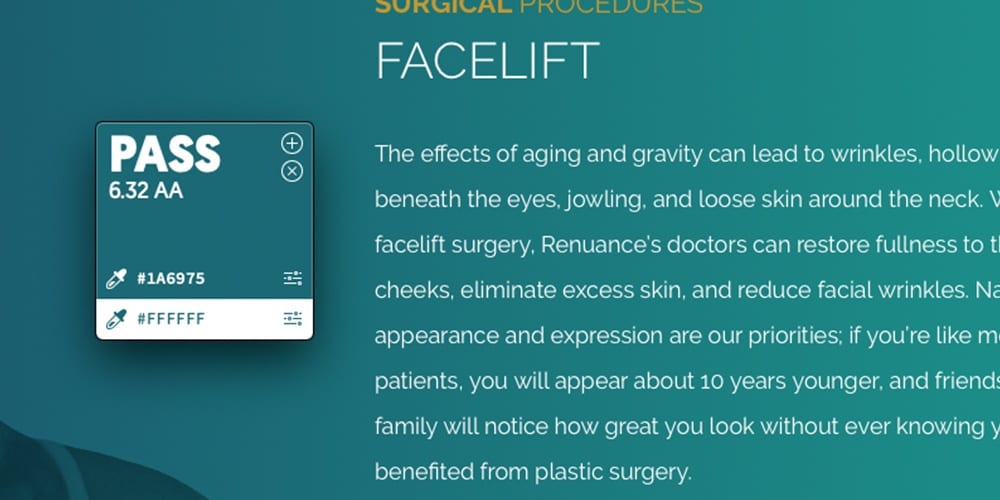Most people in the United States are already aware of the many ways in which the public environment is constantly changing to accommodate people with disabilities. However, many are not aware of the changes necessary to make their websites accessible to people with disabilities.
Web accessibility is a complicated problem. It must address accessibility concerns for people with auditory, cognitive, physical, visual, and many other disabilities. Accessible website design is, however, necessary and important to allow people with disabilities access to the full breadth of the internet, and artificial intelligence (AI) solutions have been developed to aid in designing and developing accessible websites.

Why Every Website Needs Accessible Design
Some clients may ask why they need to design their websites to accommodate people with disabilities. Here are a few reasons why it is worth designing a website with accessibility in mind.
- Expanding Customer Base: An accessible website will capture the business that an inaccessible website will naturally drive away. No amount of well-designed content, impressive visuals, or clever tools will be effective if the customer cannot navigate the site.
- Ease of Use: Many accessibility tools make it more convenient for non-disabled customers, and good accessibility design will be almost invisible to those that do not need them.
- Accessibility Litigation: A website that fails multiple accessibility requirements is not only lost potential, but is actually a liability. Recent years have seen an increase in the frequency of accessibility lawsuits. In 2017, federal courts in Florida and New York established that websites failing Web Content Accessibility Guidelines (WCAG) violate Title III of the Americans with Disabilities Act (ADA). Working to make your website more accessible to customers may help you avoid lawsuits. However, it is important to note that taking reasonable steps to be ADA compliant does not completely absolve you of the possibility of a lawsuit or threatening letter from a plaintiff’s attorney.
How AI Can Aid in Accessible Web Design
If accessibility is so important, why are the vast majority of websites failing in multiple accessibility categories? The reason is that designing an accessible website manually is very difficult. There are many features to track, and many requirements to meet that no human being can reasonably catch them all reliably. The scope of accessibility requirements is nearly insurmountable but almost necessary to work towards improving your website’s compliance efforts.
AI can make designing with accessibility both easy and effective:
- Crawling Websites: AI can crawl website code line-by-line to catch problems in the operation of a website that are not obvious visually on the webpage. Misuse of ARIA attributes is not visible on the screen, and would only be caught when attempting to interact with assistive technologies. AI can find and fix these problems that might never have been addressed otherwise.
- Catching Small Details: A 3-level deep sub-menu on one page may not be navigable by using the tab button, and a human would likely miss such a detail completely by accident. AI can easily find and resolve such small problems with ease.
- Unknown Requirements: The huge number of small accessibility requirements is daunting to remember. Even something as simple as links requires special text and ARIA labels, color differentiation, visual and audio indicators for opening both new tabs and new windows, and must be reachable by tabbing across the screen. AI can check the many hundreds of requirements against every feature of the website to ensure complete compliance.
- Fast Operation: AI can work faster than any human could possibly operate. Simple websites can be crawled in minutes or hours where a human might take full days of work to do the same.
- Dependable: An AI can be utilized to scan the same website repeatedly to ensure changes are implemented, catch new problems that may have arisen, and track fixes over time. Humans may become accustomed to a website that they have worked on for weeks, and can suffer from fatigue. An AI will never suffer these problems, operating effectively every time it is utilized.
What AI Does for Your Website
The following is a list of some of the most common services that AI offers to improve website accessibility:
- Video Transcription: An AI can flag videos or automatically transcribe videos to make them more accessible to those that are hearing impaired and require captioning or video transcriptions.
- Header Organization: An AI can flag bad header organization and even suggest fixes to ensure that anyone can find information quickly and effectively.
- Alt Tags: An AI can check every image to ensure that alt tags are present and readable by assistive technology.
- Descriptive Link Titles: AI can catch bad link titles that may frustrate people who use screen readers.
- Accessible Form Design: AI can ensure that all forms have descriptive titles and proper links to aid screen readers.
- Tabbing: Those who cannot use a mouse may need to tab through a website, and an AI will ensure that the entire website is usable with just a keyboard for those who require it.
- Color Coordination: Good color contrast is not only good design, but necessary. An AI can help catch those areas of bad color design that may be unattractive for non-disabled people, but are completely unreadable for visually impaired individuals.
- Triggering Animations: Some animations can cause problems for people with certain disabilities. AI can flag or remove animated content that could cause injury to people with disabilities (e.g., removing flashing animations that may trigger seizures).
Design an Accessible Website with AI Tools
Using AI tools is the next step in web design to drive customer interaction, make the web friendlier to people with disabilities, and help protect website owners from the threat of accessibility litigation. At Firm Media, our team utilizes the most advanced tools to offer personalized designs that are beautiful, fast, innovative, and accessible. For more information on web accessibility and compliance, reach out to schedule a demo.
Sources:
https://www2.stardust-testing.com/en/10-tips-for-web-accessibility
https://accessibe.com/blog/knowledgebase/we-analyzed-10000000-pages-and-heres-where-most-fail-with-ada-and-wcag-21-compliance
https://towardsdatascience.com/the-role-of-ai-in-web-based-ada-and-wcag-compliance-4fc09e69f416
https://www.natlawreview.com/article/when-good-sites-go-bad-growing-risk-website-accessibility-litigation



